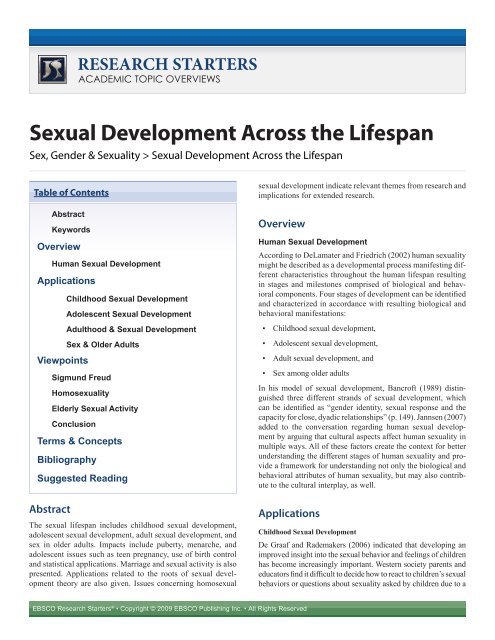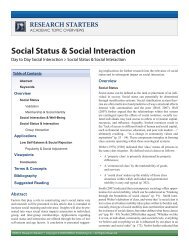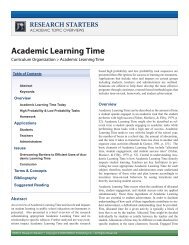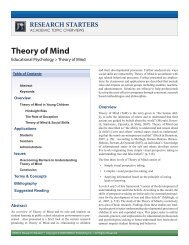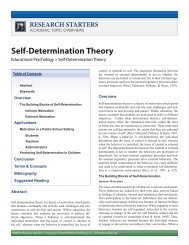Sexual Development Across the Lifespan - DSWLeads.com
Sexual Development Across the Lifespan - DSWLeads.com
Sexual Development Across the Lifespan - DSWLeads.com
Create successful ePaper yourself
Turn your PDF publications into a flip-book with our unique Google optimized e-Paper software.
RESEARCH STARTERS<br />
ACADEMIC TOPIC OVERVIEWS<br />
<strong>Sexual</strong> <strong>Development</strong> <strong>Across</strong> <strong>the</strong> <strong>Lifespan</strong><br />
Sex, Gender & <strong>Sexual</strong>ity > <strong>Sexual</strong> <strong>Development</strong> <strong>Across</strong> <strong>the</strong> <strong>Lifespan</strong><br />
Table of Contents<br />
Abstract<br />
Abstract<br />
Keywords<br />
Overview<br />
Human <strong>Sexual</strong> <strong>Development</strong><br />
Applications<br />
Viewpoints<br />
Childhood <strong>Sexual</strong> <strong>Development</strong><br />
Adolescent <strong>Sexual</strong> <strong>Development</strong><br />
Adulthood & <strong>Sexual</strong> <strong>Development</strong><br />
Sex & Older Adults<br />
Sigmund Freud<br />
Homosexuality<br />
Elderly <strong>Sexual</strong> Activity<br />
Conclusion<br />
Terms & Concepts<br />
Bibliography<br />
Suggested Reading<br />
The sexual lifespan includes childhood sexual development,<br />
adolescent sexual development, adult sexual development, and<br />
sex in older adults. Impacts include puberty, menarche, and<br />
adolescent issues such as teen pregnancy, use of birth control<br />
and statistical applications. Marriage and sexual activity is also<br />
presented. Applications related to <strong>the</strong> roots of sexual development<br />
<strong>the</strong>ory are also given. Issues concerning homosexual<br />
sexual development indicate relevant <strong>the</strong>mes from research and<br />
implications for extended research.<br />
Overview<br />
Human <strong>Sexual</strong> <strong>Development</strong><br />
According to DeLamater and Friedrich (2002) human sexuality<br />
might be described as a developmental process manifesting different<br />
characteristics throughout <strong>the</strong> human lifespan resulting<br />
in stages and milestones <strong>com</strong>prised of biological and behavioral<br />
<strong>com</strong>ponents. Four stages of development can be identified<br />
and characterized in accordance with resulting biological and<br />
behavioral manifestations:<br />
• Childhood sexual development,<br />
• Adolescent sexual development,<br />
• Adult sexual development, and<br />
• Sex among older adults<br />
In his model of sexual development, Bancroft (1989) distinguished<br />
three different strands of sexual development, which<br />
can be identified as “gender identity, sexual response and <strong>the</strong><br />
capacity for close, dyadic relationships” (p. 149). Jannsen (2007)<br />
added to <strong>the</strong> conversation regarding human sexual development<br />
by arguing that cultural aspects affect human sexuality in<br />
multiple ways. All of <strong>the</strong>se factors create <strong>the</strong> context for better<br />
understanding <strong>the</strong> different stages of human sexuality and provide<br />
a framework for understanding not only <strong>the</strong> biological and<br />
behavioral attributes of human sexuality, but may also contribute<br />
to <strong>the</strong> cultural interplay, as well.<br />
Applications<br />
Childhood <strong>Sexual</strong> <strong>Development</strong><br />
De Graaf and Rademakers (2006) indicated that developing an<br />
improved insight into <strong>the</strong> sexual behavior and feelings of children<br />
has be<strong>com</strong>e increasingly important. Western society parents and<br />
educators find it difficult to decide how to react to children’s sexual<br />
behaviors or questions about sexuality asked by children due to a<br />
EBSCO Research Starters ® • Copyright © 2009 EBSCO Publishing Inc. • All Rights Reserved
<strong>Sexual</strong> <strong>Development</strong> <strong>Across</strong> <strong>the</strong> <strong>Lifespan</strong><br />
Essay by Sharon Link, Ph.D.<br />
Keywords<br />
Adolescence<br />
Andropause<br />
Childhood <strong>Sexual</strong> <strong>Development</strong><br />
Cohabitation<br />
Gender Identity<br />
Homosocial Groups<br />
Human <strong>Sexual</strong>ity<br />
Marriage<br />
Maturity<br />
Menopause<br />
Reproduction<br />
growing societal fear regarding <strong>the</strong> risks of sexual victimization<br />
by adult predators. According to research that is available on child<br />
sexual development and a general consensus of empirical evidence,<br />
many opportunities for enhanced understanding regarding<br />
increased knowledge of childhood sexual developmental stages<br />
now exist which seems to point out “which sexual behaviors and<br />
feelings should be considered “normal” for children of certain<br />
ages, genders, or cultural backgrounds” (p. 2).<br />
According to Masters, Johnson, and Kolodny, (1982) sexual<br />
response in infants was found to be evident from birth. For<br />
example, vaginal lubrication has been identified in female<br />
infants within 24 hours after birth, and in male infants, erections<br />
have also been triggered and documented. Moreover, Martinson<br />
(1994) indicated that infants have been identified fondling <strong>the</strong>ir<br />
genitalia, and digitally manipulating <strong>the</strong>ir genitalia from 2 ½ to<br />
3 years of age. Moreover, <strong>the</strong> touching of genital parts has been<br />
documented in early childhood and even before birth (Brenot &<br />
Broussin, 1996). “After birth boys of 6 to 8 months of age and<br />
girls of 8 to 11 months of age reportedly discover <strong>the</strong>ir genitals<br />
by unintentionally touching <strong>the</strong>m” (de Graaf & Rademakers,<br />
2006, p. 4). Masturbation can be identified as a behavior that<br />
is solitary in nature and occurs when an individual touches or<br />
stimulates his or her own genitals typically for <strong>the</strong> purpose of<br />
stimulating sexual arousal (Bancroft, Herbenick, & Reynolds,<br />
2003; Goldman & Goldman, 1988). Friedrich, Fisher, Broughton,<br />
Houston and Shafran (1998) indicated that masturbatory<br />
behaviors are normal and can be observed and indicated by <strong>the</strong><br />
sexual play of young children, and be<strong>com</strong>es more clandestine in<br />
children aged 6 to 9 after children be<strong>com</strong>e more aware of cultural<br />
norms attributed to sexual behavior (Reynolds, Herbenick,<br />
& Brancroft, 2003). O<strong>the</strong>r sexual expressions might be rooted in<br />
pervasive sucking behaviors, cuddling, and o<strong>the</strong>r kinds of stimulation<br />
(de Lamater & Friedrich, 2002, p. 10).<br />
Bowlby (1965) indicated that attachments form between<br />
infants and <strong>the</strong>ir parents that impact <strong>the</strong> quality and capability<br />
of relationships and form <strong>the</strong> basis for a child’s sexual<br />
and emotional attachments and relationships throughout <strong>the</strong><br />
lifespan. Goldberg, Muir, and Kerr (1995) argued that appropriate<br />
and positive physical contact offers <strong>the</strong> opportunity to<br />
provide stable and fulfilling emotional attachments in adulthood.<br />
Moreover, <strong>the</strong> role of gender identity typically forms<br />
around <strong>the</strong> age of 3 and can be described as an individual’s<br />
sense of “maleness” or “femaleness.” At <strong>the</strong> same time biological<br />
identity forms, a behavioral manifestation of gender-role<br />
identity is being socialized by o<strong>the</strong>rs in relationship to <strong>the</strong> child<br />
(Bussey & Bandura, 1999). Goldman and Goldman (1982) fur<strong>the</strong>r<br />
identified that children from ages 3 to 7 demonstrate an<br />
increased level of sexual interest, practiced by playing house<br />
or assuming o<strong>the</strong>r adult roles tending toward gender specificity.<br />
Moreover, children might engage in “playing doctor” and demonstrate<br />
an increased interest in <strong>the</strong> genitals of o<strong>the</strong>r children or<br />
adults (Okami, Olmstead, & Abramson, 1997).<br />
Indicated by multiple researchers, <strong>the</strong> showing and touching of<br />
genitals can also be part of mutual sexual experiences between<br />
children in which both children play an active role (Goldman &<br />
Goldman, 1988; Haugaard, 1996; Lamb & Coakley, 1993; Larsson<br />
& Svedin, 2002; Reynolds, Herbenick, & Bancroft, 2003).<br />
As a result of increased sexual interest, parents may restrict <strong>the</strong><br />
information <strong>the</strong>y provide <strong>the</strong>ir children, and children may resort<br />
to gaining information from <strong>the</strong>ir peers (Martinson, 1994) leading<br />
to potential misinformation resulting in misinterpretation<br />
and misidentification. It should be noted that experiences with<br />
no direct genital contact, such as talking about sex, kissing and<br />
hugging, and exposure of genitals are most <strong>com</strong>mon in children<br />
up to 12 years. Finally, experiences with oral-genital contact,<br />
vaginal or anal insertion with an object or finger, and vaginal or<br />
anal intercourse are highly unusual between children 12-yearsold<br />
and younger (de Graaf & Rademakers, 2006, p. 11).<br />
Adolescent <strong>Sexual</strong> <strong>Development</strong><br />
Thome (1993) indicated that during <strong>the</strong> stage of preadolescent<br />
sexual development, children organize <strong>the</strong>mselves into homosocial<br />
groups, which can be described as a social division of males<br />
and females. One <strong>the</strong>ory as to why this occurs is due to <strong>the</strong> sexual<br />
exploration and learning that occurs in homosocial groups involving<br />
individuals of <strong>the</strong> same gender. Children at this stage gain<br />
experience with masturbation as identified by a study indicating<br />
that 38% of men surveyed and 40% of women surveyed recalled<br />
masturbating before <strong>the</strong> onset of puberty (Bancroft, Herbenick,<br />
& Reynolds, 2003). Fur<strong>the</strong>rmore, preadolescents at <strong>the</strong> ages of<br />
10 to 12 years begin to experience sexual attraction followed<br />
by sexual fantasies occurring from several months to one year<br />
later (Bancroft et al, 2003; Rosario, Meyer-Bahlburg, Hunter,<br />
Exner, Gwadz, & Keller, 1996). Indicatively, homosocial interactions<br />
and subsequent exposures from <strong>the</strong>se relationships may<br />
initiate <strong>the</strong> capacity for sustained intimate relationships (Thome,<br />
EBSCO Research Starters ® • Copyright © 2009 EBSCO Publishing Inc. • All Rights Reserved Page 2
<strong>Sexual</strong> <strong>Development</strong> <strong>Across</strong> <strong>the</strong> <strong>Lifespan</strong><br />
Essay by Sharon Link, Ph.D.<br />
1993). Simultaneously, behavioral changes are ac<strong>com</strong>panied by<br />
biological changes associated with puberty which begins from<br />
10 years of age to 14 years of age. From a physiological perspective,<br />
gonads, genitalia, and secondary sexual characteristics<br />
enlarge and mature during this time (Tanner, 1967) all leading to<br />
an increased sexual interest and rising levels of sexual hormones<br />
and ac<strong>com</strong>panying sexual fantasies.<br />
During adolescence bodily changes stimulate physical growth,<br />
increases in genital size and female breast size <strong>com</strong>bine with <strong>the</strong><br />
onset of facial and pubic hair. Reportedly, <strong>the</strong>se changes signal to<br />
<strong>the</strong> adolescent and to o<strong>the</strong>rs that sexual maturity is occurring. In<br />
addition to increased testosterone and estrogen levels and o<strong>the</strong>r<br />
biological factors, behavioral manifestations create opportunities<br />
for sexual interactions which facilitate or inhibit sexual expression<br />
(Udry, 1988). Bancroft, et al (2003) reported that males typically<br />
begin masturbating between <strong>the</strong> ages of 13 to 15, and girls<br />
somewhat later. However, precipitating factors for increased masturbation<br />
and heterosexual intercourse may be attributed to fa<strong>the</strong>r<br />
absence and permissive attitudes regarding sexual behavior, contrasted<br />
by regular “church attendance and long-range educational<br />
and career plans,” both of which may delay female sexual activity<br />
(de Lamater & Friedrich, 2002, p. 11).<br />
According to researchers, adolescents are having heterosexual<br />
and homosexual intercourse at earlier ages than in <strong>the</strong> past, which<br />
can be attributed to several factors. First, <strong>the</strong> age at which females<br />
have <strong>the</strong>ir first period has been falling since <strong>the</strong> beginning of <strong>the</strong><br />
twentieth century. Today, <strong>the</strong> average Caucasian female has her<br />
first period at 12.7 years of age and <strong>the</strong> average African American<br />
female has her first period at 12.5 years of age (Hofferth, 1990).<br />
Additionally, young men and women are increasingly delaying<br />
marriage. In 1960, women, on average, married for <strong>the</strong> first time<br />
at 20.8 years of age, while men, on average, married for <strong>the</strong> first<br />
time at 22.8 years of age. In 1998, <strong>the</strong> age of first marriage was<br />
25 years of age for women and 26.7 years of age for men (U.S.<br />
Bureau of <strong>the</strong> Census, 1999). Additionally, since increasing<br />
numbers of individuals are marrying later <strong>the</strong>re has been a substantial<br />
gap between biological readiness and age of marriage of<br />
typically 12 to 14 years. Finally, that <strong>the</strong> rate of teen pregnancies<br />
increased between <strong>the</strong> 1970s and 1991 would appear to indicate<br />
that teens used birth control only sporadically during <strong>the</strong>se years;<br />
however, <strong>the</strong> teen pregnancy rate declined by 18% between 1991<br />
and 1997, potentially reflecting an increased access to birth control<br />
by teens, increased attention in society to <strong>the</strong> importance of<br />
preventing pregnancy for adolescents, and increased economic<br />
opportunities for teenagers (Ventura, Mosher, Curtin, Abma, &<br />
Henshaw, 1998). Additional research should be conducted in <strong>the</strong><br />
areas of sexual education, STDs and teenagers, and birth control<br />
and consistent teen use.<br />
Studies on teen homosexual behavior indicate that between 5%<br />
and 10% of adolescent males have had sexual encounters with<br />
o<strong>the</strong>r males, while 6% of adolescent females have had sexual<br />
encounters with o<strong>the</strong>r females (Bancroft et al., 2003; Turner,<br />
Rogers, Lindberg, Pleck, Sonenstein, & Turner, 1998). The adolescents<br />
participating in <strong>the</strong>se studies generally reported that <strong>the</strong>se<br />
encounters were with a peer. Some of <strong>the</strong> participants also indicated<br />
that <strong>the</strong>se encounters were initiated out of curiosity and that<br />
<strong>the</strong> behavior was not ongoing. .<br />
According to findings from <strong>the</strong> national Youth Risk Behavior<br />
Survey, 48% of U.S. high school students had had sexual intercourse<br />
at least once (YRBS, 2007). Adolescence is certainly<br />
a pivotal time in human sexual development (de Lamater &<br />
Friedrich, 2002, p. 11).<br />
Adulthood & <strong>Sexual</strong> <strong>Development</strong><br />
Factors regarding sexual maturity continue into adulthood. Several<br />
factors play a role in adult sexual development and include<br />
effective <strong>com</strong>munication between partners engaged in intimate<br />
relationships, making informed decisions regarding reproduction<br />
and <strong>the</strong> prevention of sexually transmitted infections (such<br />
as HIV) as well as decisions regarding sexual lifestyles, sexual<br />
satisfaction, and relationship factors.<br />
Today, adults may choose among many relationship choices<br />
and lifestyles. Lifestyle choices include living single, remaining<br />
celibate, participating in a single, long-term monogamous<br />
relationship, participating in sexual relationships with several<br />
individuals, or engaging in serial monogamous relationships<br />
involving fidelity with one partner at a time for <strong>the</strong> duration of<br />
each relationship. According to <strong>the</strong> U.S. Census Bureau (2000)<br />
African American men and women more often remain single<br />
than Caucasians. In 1999, 41% of African American males<br />
and 38% of African American females were never married as<br />
contrasted with 20% of Caucasian men and 16% of Caucasian<br />
females. Among reporting singles, 26% of <strong>the</strong> men and 22% of<br />
<strong>the</strong> women usually had sex at least twice a week, while 22% of<br />
<strong>the</strong> men and 30% of <strong>the</strong> women had not had sex for at least one<br />
year (Laumann, Gagnon, Michael, & Michaels, 1994).<br />
Despite relationship alternatives, as of ten years ago, marriage<br />
was still categorized as <strong>the</strong> most prevalent sexual lifestyle choice<br />
in <strong>the</strong> United States. In 1999, 80% of women and 73% of men<br />
had been married at least once, and by <strong>the</strong> age of 45, 95% of<br />
all women were reportedly married once (U.S. Bureau of <strong>the</strong><br />
Census, 1999). According to Laumann, Gagnon, Michael, and<br />
Michaels (1994) average American couples engage in sexual<br />
intercourse 2 to 3 times per week, and marriage presents <strong>the</strong> most<br />
legitimate social context for sexual expression. In <strong>the</strong> context<br />
of marriages in <strong>the</strong> United States monogamy has been a widely<br />
accepted so practice (Wiederman & Allgeier, 1996) and extramarital<br />
sex among marital couples are significantly disapproved<br />
within <strong>the</strong> societal context (Johnson, Stanley, Glenn, Amato,<br />
Nock, & Markman, 2002); however, 34% of men and 19% of<br />
women reported engaging in extramarital sex at some point in<br />
<strong>the</strong>ir lives (Wiederman, 1997).<br />
Amos (2006) stated: “Our view of marriage, its goals and its purposes<br />
have undergone a seismic shift during <strong>the</strong> last 50 years”<br />
(p. 270). Amos (2006) indicated that during <strong>the</strong> 1960s and 1970s<br />
“a time of radical change began,” <strong>the</strong>oretically constituted by an<br />
increased availability of contraception which offered different<br />
alternatives to women than was available in previous eras (p. 270).<br />
As a result of changing female roles, and o<strong>the</strong>r contributing factors,<br />
EBSCO Research Starters ® • Copyright © 2009 EBSCO Publishing Inc. • All Rights Reserved Page 3
<strong>Sexual</strong> <strong>Development</strong> <strong>Across</strong> <strong>the</strong> <strong>Lifespan</strong><br />
Essay by Sharon Link, Ph.D.<br />
cohabitation or “living toge<strong>the</strong>r” is an increasing option, which can<br />
be characterized as a public statement regarding <strong>com</strong>mitment and<br />
sexual relationship. While cohabitation may be temporary with<br />
one-third lasting less than 1 year, according to <strong>the</strong> United States<br />
Bureau of <strong>the</strong> Census, (1999) 7% of all women living in <strong>the</strong> United<br />
States were living with males in a cohabitative relationship.<br />
Sex & Older Adults<br />
In addition to <strong>the</strong> changing context of coupling in America,<br />
o<strong>the</strong>r factors play a role in adult sexual development, as well.<br />
For example, Smith (1994) reported a decline in <strong>the</strong> frequency<br />
of sexual intercourse with age. Additionally, biological factors<br />
that include physical changes and illness may be contributors<br />
to diminished sexual expression. Gallicchio, Schilling,. Tomic,<br />
Miller, Zacur and Flaws (2007) indicated that menopause lasts<br />
approximately 4 years and begins in <strong>the</strong> mid-to-late forties with<br />
a reported decline in sexual activity during <strong>the</strong> menopausal transition<br />
(pp. 132 – 133). This occurrence might indicate that sexual<br />
frequency is tied directly to biological as well as relationship<br />
factors. The relationship between <strong>the</strong> menopausal transition and<br />
decreased sexual function has been observed in women despite<br />
relationship variables. These relationship variables include “general<br />
well-being, physical and mental health, <strong>the</strong> occurrence of<br />
menopausal symptoms, and life situation (p. 133). Moreover, a<br />
“hallmark of <strong>the</strong> menopausal transition is a decline in ovarian<br />
function, resulting in dramatic changes in hormone levels” (p.<br />
133). Additional studies should be considered on <strong>the</strong> impacts of<br />
biological, physical, relationship, emotional and mental health<br />
impacts of aging and sexual development.<br />
In contrast with women, men experience andropause (Lamberts,<br />
van den Beld, & van der Lely, 1997) which can be described<br />
as a ADAM-androgen decline that occurs as men age, resulting<br />
in a gradual decline in testosterone production, which can<br />
occur as early as age 40 (Morales, Heaton, & Carson, 2000).<br />
During this time, erections may occur more slowly, and men<br />
may experience increased control over <strong>the</strong>ir sexual response.<br />
According to AARP (1999) older, healthy humans 74 years<br />
and older may continue to have regular opportunities for satisfying<br />
sexual expression in all forms including masturbation<br />
and homo-sexual behavior (de Lamater & Friedrich, 2002, p.<br />
13). It would seem that much more research exists in terms of<br />
female menopause as opposed to male andropause. Additional<br />
research should be considered in this area.<br />
Viewpoints<br />
Sigmund Freud<br />
From a developmental application, <strong>the</strong> study of childhood<br />
sexuality is rooted in <strong>the</strong> work of Sigmund Freud. According<br />
to Galatzer-Levy & Cohler, (1993) Freud approached <strong>the</strong>ories<br />
related to childhood sexuality from <strong>the</strong> viewpoint of a male child.<br />
Indicatively, Freud postulated that life could best be understood<br />
from <strong>the</strong> viewpoint of a child, and he believed post-adolescent<br />
development was non-existent. Moreover, Freud viewed sexuality<br />
as “a generalization of <strong>the</strong> pleasures associated with mucous<br />
membrane stimulation, and as <strong>the</strong> central motive for relating<br />
to o<strong>the</strong>r people” (p. 5). Anzieu (1975) indicated that much of<br />
Freud’s beliefs regarding sexual development were rooted in his<br />
own experiences, postulating that Freud was jealous of his own<br />
fa<strong>the</strong>r and had formed an erotic attachment to his mo<strong>the</strong>r.<br />
Moreover, many of Freud’s <strong>the</strong>ories toward childhood sexuality<br />
and fascination could be exemplified by <strong>the</strong> Shakespeare’s<br />
character, Hamlet, who similarly possessed an incestuous desire<br />
toward his mo<strong>the</strong>r and possessed ambivalence toward his dead<br />
fa<strong>the</strong>r, later displaced by a burgeoning hatred toward his stepfa<strong>the</strong>r<br />
(pp. 235 – 236). Anzieu (1975) argued that Freud’s work<br />
was greatly influenced by his treatment of a man who suffered<br />
from an obsessional neurosis and homicidal thoughts, ailments<br />
which Freud identified in himself (Cohler & Galatzer-Levy,<br />
2008). While seemingly a potentially strange application,<br />
Freud’s work is considered to be a key developmental aspect of<br />
human sexuality and deserves additional research into <strong>the</strong> foundations<br />
of developmental psychology and sexuality.<br />
Homosexuality<br />
Significant issues related to human sexual development are those<br />
related to gay and bisexual men, which has received some research<br />
in <strong>the</strong> social sciences (Berger, 1996; Grossman, D’Augelli, &<br />
Hershberger, 2000; Lee, 1989; Vacha, 1985). Significant gaps in<br />
<strong>the</strong> literature have especially related to HIV risk and prevention.<br />
Murry and Adam (2001) researched and identified several <strong>the</strong>mes<br />
regarding homosexuality and human sexual development. Some<br />
of <strong>the</strong> <strong>the</strong>mes included public image as represented by <strong>the</strong> media,<br />
relationships between younger and older men and <strong>the</strong> orientation<br />
of youthfulness in gay culture, a search for intimacy at all ages,<br />
and <strong>the</strong> impact of an entire generation marked by AIDS/HIV. All<br />
of <strong>the</strong>se issues were indicated to have played a significant role<br />
in <strong>the</strong> human sexual development of homosexual males. From a<br />
research perspective, it would be interesting to determine lesbian<br />
correlates in order to better understand how female homosexual<br />
orientation might be manifested.<br />
Elderly <strong>Sexual</strong> Activity<br />
Ano<strong>the</strong>r important issue regarding human sexuality and development<br />
relates to attitudes, especially those which define specific<br />
behaviors as appropriate or inappropriate. According to DeLamater<br />
& Friedrich (2002) sexual attitudes especially relate to age<br />
factors and sexual expression and <strong>the</strong> elderly. <strong>Sexual</strong> attitudes<br />
and prejudice are perpetuated by <strong>the</strong> unacceptable notion that<br />
individuals over 75 should not engage in sexual activity, especially<br />
masturbation. A derivative of <strong>the</strong>se attitudes is directly<br />
linked to negative attitudes in elder care facilities and nursing<br />
homes. Often times, sexual behavior between aged individuals<br />
in <strong>the</strong>se kinds of facilities are prohibited. “These attitudes affect<br />
<strong>the</strong> way <strong>the</strong> elderly are treated, and <strong>the</strong> elderly may hold such<br />
attitudes <strong>the</strong>mselves. These attitudes may be a more important<br />
reason why many elderly people are not sexually active than <strong>the</strong><br />
biological changes <strong>the</strong>y experience” (p. 13). Additional work<br />
should be considered in creating a “system of diversity” for all<br />
EBSCO Research Starters ® • Copyright © 2009 EBSCO Publishing Inc. • All Rights Reserved Page 4
<strong>Sexual</strong> <strong>Development</strong> <strong>Across</strong> <strong>the</strong> <strong>Lifespan</strong><br />
Essay by Sharon Link, Ph.D.<br />
individuals regardless of age or sexual orientation.<br />
Conclusion<br />
Human sexual development across <strong>the</strong> lifespan is a dynamic<br />
phenomenon with multiple facets. According to researchers,<br />
studies of childhood sexuality are difficult to obtain, because<br />
of <strong>the</strong> potential victimization of children. However, studies that<br />
do exist demonstrate that children of all ages display behaviors<br />
or have feelings that could be identified as sexual in nature.<br />
DeLamater & Friedrich (2002) indicated that human sexual<br />
development begins in infancy and certainly extends across <strong>the</strong><br />
lifespan of humans. Conclusively, human sexuality integrates<br />
both behavioral and biological factors manifested in aging,<br />
child development, adolescence and puberty, adulthood, and old<br />
age. <strong>Development</strong> at all of <strong>the</strong>se stages shapes sexual attitudes<br />
and sexual identity and directly impact sexual behavior. While<br />
humans certainly share similarities in <strong>the</strong>ir sexual progression,<br />
it is fur<strong>the</strong>r indicated that differences are also present (p. 13).<br />
Additional research should be considered in all areas of human<br />
sexual development in order to shed light on this area of continued<br />
interest and importance in sociological studies and society.<br />
Terms & Concepts<br />
Childhood <strong>Sexual</strong> <strong>Development</strong>: Childhood sexual developmental<br />
can be described as stages that take place throughout<br />
childhood which seems to point out which sexual behaviors and<br />
feelings should be considered “normal” for children of certain<br />
ages, genders, or cultural backgrounds.<br />
Cohabitation: Cohabitation can be described “living toge<strong>the</strong>r,”<br />
which can be characterized as a public statement regarding <strong>com</strong>mitment<br />
and sexual relationship as an alternative to marriage.<br />
Gender Identity: Gender identity can be described as a process<br />
that begins to develop typically around <strong>the</strong> age of 3 and can be<br />
described as an individual’s sense of “maleness” or “femaleness.”<br />
Homosocial Groups: Homosocial groups can be described<br />
as a social division of males and females in group settings.<br />
Human <strong>Sexual</strong>ity: Freud believed that human sexuality is a<br />
driving force in people’s relations with one ano<strong>the</strong>r.<br />
Bibliography<br />
Amos, C. (2006). Marriage – and its alternatives: An Anglican<br />
perspective, yesterday, and today. Islam & Christian –<br />
Muslim Relations, 17(3), 269 – 279. Retrieved September<br />
13, 2008 from EBSCO online database Academic Search<br />
Premier: http://search.ebscohost.<strong>com</strong>/login.aspxdirect=tr<br />
ue&db=aph&AN=22018255&site=ehost-live<br />
Anzieu, D. (1975). Freud’s self-analysis, P. Graham, trans.<br />
Madison, CT: International Universities Press, 1986.<br />
Bancroft, J. (1989). Human sexuality and its problems.<br />
Edinburgh, Scotland: Churchill Livingstone.<br />
Bancroft, J., Herbenick, D., & Reynolds, M. (2003).<br />
Masturbation as a marker of sexual development. In<br />
J. Bancroft (Ed.), <strong>Sexual</strong> <strong>Development</strong> in Childhood.<br />
Bloomington, IN: Indiana University Press.<br />
Berger, R. (1996). Gay and gray. New York: Haworth Press.<br />
Bowlby, J. (1965). Maternal care and mental health. In J.<br />
Bowlby (Ed.). Child care and <strong>the</strong> growth of love. London:<br />
Penguin.<br />
Brenot, P. & Broussin, B. (1996). Orgasme in utero<br />
Sexologies, 5(21), 15–16.<br />
Bussey, K., & Bandura, A. (1999). Social cognitive <strong>the</strong>ory of<br />
gender development and differentiation. Psychological<br />
Review, 106, 676-713.<br />
Cohler, B. J. & Galatzer-Levy, R. M. (2008). Freud, Anna, and<br />
<strong>the</strong> problem of female sexuality. Psychoanalytic Inquiry,<br />
28, 3 – 26. Retrieved September 13, 2008 from EBSCO<br />
online database Academic Search Premier: http://search.<br />
ebscohost.<strong>com</strong>/login.aspxdirect=true&db=aph&AN=300<br />
55722&site=ehost-live<br />
De Graaf, H. & Rademaker, J. (2006). <strong>Sexual</strong> behavior of<br />
prepubertal children. Journal of Psychology & Human<br />
<strong>Sexual</strong>ity, 18(1), 1 – 21. Retrieved September 13, 2008<br />
from EBSCO online database Academic Search Premier:<br />
http://search.ebscohost.<strong>com</strong>/login.aspxdirect=true&db=a<br />
ph&AN=23085915&site=ehost-live<br />
DeLamater, J. & Friedrich, W. N. (2002). Human sexual<br />
development. Journal of Sex Research, 39(1), 10 – 14.<br />
Retrieved September 13, 2008 from EBSCO online database<br />
Academic Search Premier: http://search.ebscohost.<br />
<strong>com</strong>/login.aspxdirect=true&db=aph&AN=6773761&site<br />
=ehost-live<br />
Friedrich, W. N., Fisher, J., Broughton, D., Houston, M., &<br />
Shafran, C. R. (1998). Normative sexual behavior in children:<br />
A contemporary sample. Pediatrics, 101(4). 693<br />
- 697. Retrieved September 13, 2008 from EBSCO online<br />
database Academic Search Premier: http://search.ebscohost.<strong>com</strong>/login.aspxdirect=true&db=aph&AN=449559&<br />
site=ehost-live<br />
Galatzer-Levy, R. M. & Cohler, B. J. (1993). The essential<br />
o<strong>the</strong>r. NewYork: Persus Books/Basic Books.<br />
Gallicchio, L., Schilling, C., Tomic, D., Miller, S. R., Zacur,<br />
H., Flaws, J. A. (2007). Correlates of sexual functioning<br />
among mid-life women. Climacteric, 10(2), 132 – 142.<br />
EBSCO Research Starters ® • Copyright © 2009 EBSCO Publishing Inc. • All Rights Reserved Page 5
<strong>Sexual</strong> <strong>Development</strong> <strong>Across</strong> <strong>the</strong> <strong>Lifespan</strong><br />
Essay by Sharon Link, Ph.D.<br />
Retrieved September 13, 2008 from EBSCO online database<br />
Academic Search Premier: http://search.ebscohost.<br />
<strong>com</strong>/login.aspxdirect=true&db=aph&AN=24504803&sit<br />
e=ehost-live<br />
Goldberg, S., Muir, R., & Kerr, J. (1995). Attachment <strong>the</strong>ory:<br />
Social, developmental, and clinical perspectives.<br />
Hillsdale, NJ: Analytic Press.<br />
Goldman, R. J., & Goldman, J. D. G. (1982). Children’s sexual<br />
thinking. London: Routledge and Kegan Paul.<br />
Goldman, R., & Goldman, J. (1988). Show me yours: What<br />
children think about sex. Victoria, Australia: Penguin<br />
Books.<br />
Grossman, A., D’Augelli, A., & Hershberger, S. (2000). Social<br />
support networks of lesbian, gay, and bisexual adults 60<br />
years of age and older. Journals of Gerontology: Series B,<br />
55B, 171 – 179.<br />
Haugaard, J.J. (1996). <strong>Sexual</strong> behaviors between children:<br />
Professionals’ opinions and undergraduates’ recollections.<br />
Families in Society: The Journal of Contemporary Human<br />
Services, 77, 81-89.<br />
Hofferth, S. L. (1990). Trends in adolescent sexual activity,<br />
contraception, and pregnancy in <strong>the</strong> United States. In J.<br />
Bancroft & J. Reinisch (Eds.), Adolescence and puberty<br />
(pp. 217-233). New York: Oxford University Press.<br />
Janssen, D. F. (2007). First stirrings: Cultural notes on orgasm,<br />
ejaculation, and wet dreams. Journal of Sex Research,<br />
44(2), 122 – 134. Retrieved September 13, 2008 from<br />
EBSCO online database SocINDEX with Full Text. http://<br />
search.ebscohost.<strong>com</strong>/login.aspxdirect=true&db=sih&A<br />
N=25138345&site=ehost-live<br />
Johnson, C.A., Stanley, S.M., Glenn, N.D., Amato, P.A., Nock,<br />
S.L., & Markman, H.J. (2002). Marriage in Oklahoma:<br />
2001 baseline statewide survey on marriage and divorce<br />
(S02096 OKDHS). Oklahoma City, OK: Oklahoma<br />
Department of Human Services.<br />
Lamb, S., & Coakley, M. (1993). “Normal” childhood sexual<br />
play and games: Differentiating play from abuse. Child<br />
Abuse & Neglect, 17, 515-526.<br />
Lamberts, S. W. J., Van den Beld, A., & Van der Lely, A.J.<br />
(1997). The endocrinology of aging. Science, 278, 419 -<br />
424. Retrieved September 13, 2008 from EBSCO online<br />
database Academic Search Premier: http://search.ebscohost.<strong>com</strong>/login.aspxdirect=true&db=aph&AN=97103035<br />
70&site=ehost-live<br />
Larsson, I., & Svedin, C.G. (2002). <strong>Sexual</strong> experiences in<br />
childhood: Young adults’ recollections. Archives of <strong>Sexual</strong><br />
Behavior, 31, 263-273.<br />
Laumann, E. O., Gagnon, J. H., Michael, R. T., & Michaels,<br />
S. (1994). The social organization of sexuality: <strong>Sexual</strong><br />
practices in <strong>the</strong> United States. Chicago: The University of<br />
Chicago Press.<br />
Lee, J. (1989). Invisible men. Canadian Journal on Aging, 8,<br />
79 – 97.<br />
Martinson, F. M. (1994). The sexual life of children. Westport,<br />
CT: Bergin and Garvey.<br />
Masters, W. H., Johnson, V. E., & Kolodny, R. C. (1982).<br />
Human sexuality. Boston: Little, Brown.<br />
Morales, A., Heaton, J. P. W., & Carson, C. C. (2000).<br />
Andropause: A misnomer for a true clinical entity.<br />
Journal of Urology, 163, 705-712.<br />
Murry, J. & Adam, B. D. (2001). Aging, sexuality, and HIV<br />
issues among older gay men. Canadian Journal of Human<br />
<strong>Sexual</strong>ity, 10(3/4), 75 – 91. Retrieved September 13, 2008<br />
from EBSCO online database Academic Search Premier:<br />
http://search.ebscohost.<strong>com</strong>/login.aspxdirect=true&db=a<br />
ph&AN=7387603&site=ehost-live<br />
Okami, P., Olmstead, R., & Abramson, R. (1997). <strong>Sexual</strong><br />
experiences in early childhood: 18-year longitudinal data<br />
from <strong>the</strong> UCLA Family Lifestyles Project. The Journal of<br />
Sex Research, 34, 339-347. Retrieved September 13, 2008<br />
from EBSCO online database Academic Search Premier:<br />
http://search.ebscohost.<strong>com</strong>/login.aspxdirect=true&db=a<br />
ph&AN=501176&site=ehost-live<br />
Reynolds, M.A., Herbenick, D.L., & Bancroft, J.H. (2003).<br />
The nature of childhood sexual experiences: Two studies<br />
50 years apart. In J. Bancroft (Ed.), <strong>Sexual</strong> <strong>Development</strong><br />
in Childhood. Bloomington, IN: Indiana University Press.<br />
Rosario, M., Meyer-Bahlburg, H., Hunter, J., Exner, T., Gwadz,<br />
M., & Keller. A. (1996). The psychosexual development of<br />
urban lesbian, gay and bisexual youths. The Journal of Sex<br />
Research, 33, 113-126. Retrieved September 13, 2008 from<br />
EBSCO online database Academic Search Premier: http://<br />
search.ebscohost.<strong>com</strong>/login.aspxdirect=true&db=aph&AN<br />
=9607254538&site=ehost-live<br />
Smith, T. W. (1994). The demography of sexual behavior.<br />
Menlo Park, CA: Kaiser Family Foundation.<br />
Tanner, J. M. (1967). Puberty. In A. McLaren (Ed.), Advances<br />
in reproductive physiology (Vol. II). New York: Academic<br />
Press.<br />
Thome, B. (1993). Gender play: Girls and boys in school. New<br />
EBSCO Research Starters ® • Copyright © 2009 EBSCO Publishing Inc. • All Rights Reserved Page 6
<strong>Sexual</strong> <strong>Development</strong> <strong>Across</strong> <strong>the</strong> <strong>Lifespan</strong><br />
Essay by Sharon Link, Ph.D.<br />
Brunswick, NJ: Rutgers University Press.<br />
Turner, C. F., Ku, L., Rogers, S. M., Lindberg, L. D., Pleck, J. H.<br />
& Sonenstein, F. L. (1998). Adolescent sexual behavior, drug<br />
use, and violence: Increased reporting with <strong>com</strong>puter survey<br />
technology. Science, 280, 867 – 868. Retrieved September<br />
13, 2008 from EBSCO online database Academic Search<br />
Premier: http://search.ebscohost.<strong>com</strong>/login.aspxdirect=true<br />
&db=aph&AN=583885&site=ehost-live<br />
Udry, J. R.. (1988). Biological predispositions and social control<br />
in adolescent sexual behavior. American Sociological<br />
Review, 53, 709-722. Retrieved September 13, 2008 from<br />
EBSCO online database Academic Search Premier: http://<br />
search.ebscohost.<strong>com</strong>/login.aspxdirect=true&db=aph&A<br />
N=14789939&site=ehost-live<br />
U.S. Bureau of <strong>the</strong> Census. (1999). Statistical abstract of <strong>the</strong><br />
United States, 1999. Washington, DC: Author. http://www.<br />
census.gov/prod/99pubs/99statab/sec02.pdf<br />
U.S. Bureau of <strong>the</strong> Census. (2000), Statistical abstract of <strong>the</strong><br />
United States, 2000. Washington, DC: Author. http://<br />
www.census.gov/main/www/cen2000.html<br />
Vacha, K. (1985). Quite fire. Trumansburg, NY: Crossing Press.<br />
Ventura, S. J., Mosher, W. D., Curtin, S. A, Abma, J. C,<br />
& Henshaw, S. (2001). Trends in pregnancy rates for<br />
<strong>the</strong> United States, 1976-1997. National Vital Statistics<br />
Reports, 49(4).<br />
attributions regarding extramarital sex among young<br />
married individuals. Journal of Psychology and Human<br />
<strong>Sexual</strong>ity, 8, 21–35.<br />
Youth Risk Behavior Survey (2007). Available at http://www.<br />
cdc.gov/HealthyYouth/yrbs/pdf/yrbs07_us_sexual_behaviors_trend.pdf<br />
Suggested Reading<br />
Chodorow, N. (1999). The power of feelings. New Haven, CT:<br />
Yale University Press.<br />
Friedman, R. C. (1988). Male homosexuality: A contemporary<br />
psychoanalytic perspective. New Haven, CT: Yale<br />
University Press.<br />
Gay, P. (1988). Freud: A life for our time. New York: W. W.<br />
Norton.<br />
Martinson, F. M. (1994). The sexual life of <strong>the</strong> child. Westport,<br />
CT: Bergin & Garvey.<br />
Schur, M. (1972). Freud living and dying. New York:<br />
International Universities Press.<br />
Thatcher, A. (1999). Marriage after modernity: Christian marriage<br />
in postmodern times. Sheffield: Sheffield Academic<br />
Press.<br />
Essay by Sharon Link, Ph.D.<br />
Dr. Sharon Link is an educator, presenter, and mo<strong>the</strong>r of a child with autism. She has worked extensively in public education and<br />
has researched education and its relationship to autism disorders and o<strong>the</strong>r disabilities for <strong>the</strong> last ten years. Dr. Link currently is <strong>the</strong><br />
Executive Director for Autism Disorders Leadership Center, a non-profit research center and is co-founder of Asperger Interventions &<br />
Support, Inc. a professional development center. Both organizations are education and research centers seeking to improve education by<br />
creating a system of diversity and inclusion in America’s schools. To learn more, visit: Asperger Help at http://aspergerhelp.net.<br />
Wiederman, M.W., & Allgeier, E.R. (1996). Expectations and<br />
EBSCO Research Starters ® • Copyright © 2009 EBSCO Publishing Inc. • All Rights Reserved Page 7


